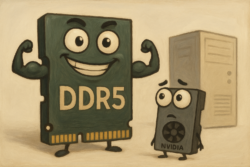Let me tell you something you don’t hear every day: the next semiconductor revolution may not be coming out of Silicon Valley, Taiwan, or a shiny new megafab in Arizona. It might be rolling out of a shipping container in Durham, England.
The entire way we think about and look at semiconductor (“chip”) manufacturing is due for a hard reset. While the world obsesses over ASML’s $380 million EUV machines and $20 billion giga-fabs, a British outfit called Pragmatic Semiconductor is quietly deploying what they call a “Fab-in-a-Box.” It’s a fully functional chip factory that fits inside a space smaller than a high school basketball court.
You might not have heard of Pragmatic. But in this era of semiconductors being labelled “the new oil,” what they’re building is a refinery the size of a shed, and that changes everything.
Small Box, Big Disruption
For the uninitiated, building chips usually means capital outlays that would make a sovereign wealth fund wince. We’re talking $10–20 billion per fab, around three years of construction, specialist water and cooling systems, huge amounts of infrastructure to lay down, power usage that is forcing even big tech to now realign their entire energy strategy, and most critically a dependence on ASML’s lithography machines that can only be described as ‘technological wizardry.’ Each machine costs around $380 million.
But Pragmatic is saying, “what if we don’t need any of that?”
We’re not 100% sure of the starting price of Pragmatic’s Fab-in-a-Box. But according to EE Times it, “…will cost orders of magnitude less than the typical chip fab with a $20 billion price tag, and they can start production in about a third of the time.”
Admittedly, they’re not about to put Nvidia out of business. This fab makes simpler chips, which is a key point, not everything needs to be a 3nm logic processor.
These fabs crank out flexible, thin-film chips, perfect for sensors, smart packaging, power modules, wearables, and, yes, even parts of the AI supply chain.
In other words, they’re cutting the cost, complexity, and carbon footprint of chipmaking by several orders of magnitude. And they’re doing it faster than the incumbents can even finish pouring concrete.
What’s also exciting about this is its British innovation, and it holds the potential to give the UK a very strong bargaining chip at the trade negotiations table.
Made in Britain, Ignored by the World (for now)
The US Department of Defence is grappling with how to secure its supply chain of so-called “legacy nodes” – chips that don’t need bleeding-edge lithography but are mission-critical for missiles, radar, and spacecraft.
They’ve even gone down the path of launching the OpenROAD project through DARPA to develop open-source electronic design automation tools, facilitating more accessible and rapid chip design processes.
While there’s no direct partnership or purchase order from the DoD, the end game and vision is still the same. Low-cost chip fabrication, quick, high volume, flexible and functional, anywhere in the world.
Imagine a Pragmatic fab-in-a-box dropped onto domestic Air Force base, a submarine dock, or a secure government lab or an overseas military base. They could churn out radiation-hardened chips, power semiconductors, and sensor arrays all without waiting two years for a TSMC buildout in Arizona.
That gives the end user a strategic technology advantage.
Here’s where this ties into the big picture and potentially your portfolio. AI chips are in bottleneck hell. Everyone’s fighting over Nvidia’s H100s, and the Blackwell series of chips and so on – Nvidia’s queue isn’t getting shorter.
But a fully functioning AI ecosystem isn’t just GPUs. It’s power management integrated circuits, sensor chips, memory interfaces, and custom logic accelerators.
Add AI management into the system and you have OpenROAD’s end goal of no-human-in-process chip design, fabrication and delivery on site, fast, cheap, easy.
Think about that for a moment: a modular fab, powered by AI, building chips that power AI. That feedback loop is the kind of thing that turns industry disruption into exponential acceleration.
It’s also a reminder that innovation doesn’t have to look like a $30B foundry. Sometimes, it looks like a clean white box on a university campus, quietly churning out the future.
Strategic edge, ahead of the curve
If you’re waiting for Bloomberg to ring the bell on this one, you’ll already be late. I expect the next big move by the chip industry is technological decentralisation. We saw it in computing, mainframes to PCs, PCs to smartphones. We’re starting to see it unfold in energy with the idea of small modular reactors for nuclear energy.
Now we’re seeing it in semiconductors, from giant fabs to modular, small, fast-paced outcomes.
Modular fabs aren’t here to replace TSMC or Intel. They’re here to complement, fill gaps, and multiply supply. They will get to places that the giants could never reach, and they’re providing a strategic technology advantage to those who will end up using them.
As geopolitical instability, chip shortages, and manufacturing pressures converge on the same timeline, companies like Pragmatic—those that provide a solution—become invaluable.
Pragmatic is still private for now but watch the space. It’s likely too that more modular fab companies pop up, in the UK, in the US, on the stock markets.
When the chip revolution does go modular, we’ll be right there ready for it.
Until next time,

Sam Volkering
Contributing Editor, Investor’s Daily
PS. There’s a reason oil, steel, and rail shaped the rise of America—and it wasn’t just industrial muscle. It was ownership. Now, a new kind of economic power is being unlocked.
One tied to what Jim Rickards calls “The American Birthright.”
It involves an estimated $150 trillion shift… a legal loophole… and an opportunity most investors still don’t know exists.
Click here to see what’s coming—and how to claim your stake.
The Great Game
Bill Bonner, writing from Youghal, Ireland
‘I resemble that remark.’
–Curly Howard
Like internet advertising, the tariff news keeps coming. Quartz:
A group of Wedbush analysts led by Dan Ives sent a note Tuesday…“This auto tariff (in its current form) will send the auto industry into upside down mode and raise the average price of cars between $5k on the low end and $10k to $15k on the high end.”
The Daily Mail:
Xia Baolong, a top Chinese official…’Let those peasants in the United States wail in front of the 5,000 years of Chinese civilization,’ Xia, the director of China’s Hong Kong and Macau Affairs Office under the State Council, said in a televised speech today.
But what are we watching? Is it a 21st century version of the Great Game…in which the world’s most powerful nations make moves and counter-moves…one trying to protect its empire…the other trying to save face? The Raw Story:
Trade war set to ‘get really ugly’ as ‘Xi won’t back down’: Ex-Trump official
As the White House claims they have the ‘upper hand’ in the China trade war, a new POLITICO report is claiming otherwise…
According to the outlet, Trump’s exceptions are “indicative of the relatively weak position of the administration.”
They also noted a second problem with the tariffs: “The U.S. is imposing new tariffs on Chinese goods in an attempt to move manufacturing back to the U.S., but those tariffs are particularly painful for U.S. manufacturers because they are currently so dependent on Chinese parts.”
In retrospect, the 19th century ‘Great Game’ between Russia and England was a waste of time, money, and lives. Russia believed it was protecting the southern Caucasus from further English colonization. England thought it was protecting India. Neither was a realistic threat.
So maybe this trade spat is not so important, either. Maybe it’s just an entertaining farce…’Trade Stooges’…nyuk…nyuk…nyuk… in which the lead characters whack each other for the benefit of the audience…but nobody actually gets hurt?
They punch. They poke. But no hard feelings!
AP is reporting that Donald Trump, for all his vaudeville jabs, flip flops more than a pair of beach sandals:
Trump considers pausing his auto tariffs as the world economy endures whiplash
“I’m looking at something to help some of the car companies with it,” Trump told reporters gathered in the Oval Office. The Republican president said automakers needed time to relocate production from Canada, Mexico and other places, “And they need a little bit of time because they’re going to make them here, but they need a little bit of time. So I’m talking about things like that.”
In a non-stooge comedy, a leader might want to talk “about things like that” before threatening billions in trade…thousands of jobs…and millions of family budgets.
Besides, there is no way the auto companies are going to relocate production to the US in just a few months. And maybe never. The New York Post:
Honda on Tuesday said it has no plans to move car production from Canada and Mexico to the US, following a report that the Japan auto giant was considering shifting some operations to avoid potentially devastating tariffs.
So, what’s this really about? This is just show business, right?
Maybe not.
Maybe more like ‘The Guns of August’…in which the leading powers blunder into a catastrophic war, with no real cause…no practical strategy…and with nothing really at stake. Once underway, there’s no acceptable outcome…except to win…at any cost. Irish Star:
China orders all airlines to stop taking deliveries from Boeing as trade war explodes
As the trade war with the US intensifies, China has halted deliveries from Boeing…In response, Chinese officials have instructed airlines to cease accepting deliveries from Boeing and to stop purchasing aircraft-related equipment and parts from American companies.
And this from the newswires:
China has sent naval vessels to the wider Western Pacific Ocean via waterways near Japan after a United States aircraft carrier reached the contested region, along with an advanced warship. The Japanese military on Monday announced that three Chinese naval ships had sailed in the waters southwest of Japan on Friday. They were the Type 052C destroyer CNS Changchun, the Type 054A frigate CNS Yangzhou and the Type 903 replenishment ship CNS Qiandaohu.
The Stooges?
The Great Game?
WWI?
Remember how movie theaters used to offer a ‘double feature?’ This looks like a triple feature to us!
Get your popcorn…and your gold…now.
Regards,

Bill Bonner
Contributing Editor, Investor’s Daily
For more from Bill Bonner, visit www.bonnerprivateresearch.com



